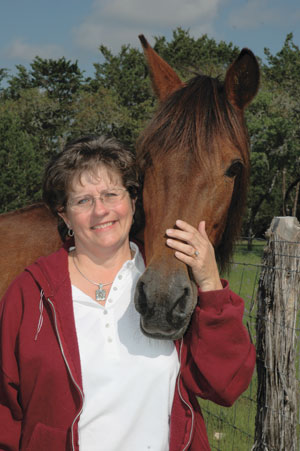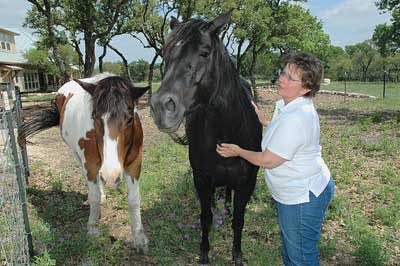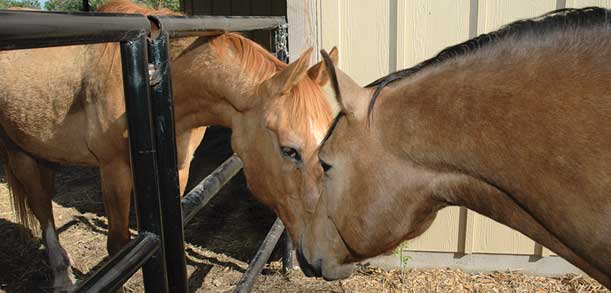
Karen Thomas and adopted horse Paulina
Photos by Sheryl Smith-Rodgers
Weak and starved, Billie — a great-grandson of Secretariat, an American racehorse who won the Triple Crown and set records in the 1970s — could barely stand when rescuers seized him from negligent owners in 2007. “I cried when they backed him out of the trailer,” recalls Karen Thomas, who fosters abused horses through an equine protection organization called Habitat for Horses. “I couldn’t believe anyone could be so cruel.”
Undaunted by the six-year-old’s shocking condition, Karen set to work rehabilitating Billie. “I went out to our barn every two hours to make sure he was still alive,” she says. “I was so panicked that I was going to lose him. You don’t know if a horse is going to make it sometimes.”
or two weeks, she and her husband, Joe, nursed the malnourished animal. “You can’t just give a horse in that condition a bale of hay,” Karen explains. “Instead, I fed him a handful of hay every two hours, plus a handful of feed twice a day, to get him used to eating again. A few days later, I added handfuls of alfalfa. Then after that, I haltered him and let him graze for five minutes, then 10 minutes and so on. It was a slow process.”
The Thomases’ diligent care paid off. Seven months later, Billie — transformed into a vigorous, alert and happy horse — stepped onto a trailer and headed to his new home in North Texas. “That’s the great part — when a horse survives and goes on to have a life,” Karen says.
Unexpected Transformations
Ironically, Billie transformed the couple’s life as well. “My husband was so impacted by that horse that he wanted to do more,” Karen says. “So we decided to buy a bigger piece of land, so we could foster more horses.”
At the time, the couple lived on 10 acres in a restricted subdivision outside of San Antonio, Texas. Through Capital Farm Credit in Kerrville, they financed the purchase of 45 rural acres in the Texas Hill Country. The branch also financed construction of their limestone home and six-stall barn.
“Capital Farm Credit and our loan officer, Steven Ahrens, made the process of buying land and building a house and barn a very simple experience,” Karen says. “Because they were so on the ball, the building phase only took seven months. That was important to us, especially after our experience with Billie, because we felt even stronger about helping rescue horses.”
“My husband was so impacted by that horse that he wanted to do more. So we decided to buy a bigger piece of land, so we could foster more horses.” – Karen Thomas
Since joining Habitat for Horses in December 2006, Karen and Joe have fostered 13 horses.
An avowed animal lover, Karen started riding at age seven. Joe, on the other hand, mostly kept to his studies as a kid. That changed after he married Karen. Today, the couple shares their small ranch with six cats, one black Lab and four horses of their own — Dolly and Pooh Bear plus Whitney and Paulina, two rescue horses they adopted.
Fostering Change
The Thomases learned about Habitat for Horses nearly four years ago from a former neighbor, who told them about the urgent need for foster homes. They discussed the idea and quickly decided to move forward. After going through the application process, Habitat accepted the couple and sent them Rose, a sorrel mare, in December 2006. Then, one at a time, came Medina, Ringo, Billie and others. Since their move to the Hill Country, the couple now has ample room for two or three foster horses. Karen documents each one with notes and photos she keeps in a black spiral-ring notebook.

Karen and her Horses
Photo by Sheryl Smith-Rodgers
Thomas, an old roping horse, arrived last December as a foster case through Habitat for Horses. During his time with the Thomases, he’s put on weight and learned to trust humans again. “Thomas is a doll,” Karen says affectionately. “We just love him. But because he was a working horse, he’s not used to befriending humans. He’s coming around, though, and that’s what we do: We get the horses back on their feet so they can go to a permanent home.”
As foster owners, she and Joe cover food and farrier costs; Habitat pays the veterinary bills.
One of the couple’s recent success stories is Kiddo, a three-year-old gelding, adopted by Denise and Lance Crawford. “Instead of spending lots of money on a horse we knew nothing about, we decided to help some out,” says Denise, a Habitat volunteer and a customer service representative with Capital Farm Credit.
Still So Much To Give
The Crawfords and their daughter, Cheyenne, also adopted Baylee, a paint, and Piper, an Arabian. “Piper’s a sweetheart,” Lance says. “She was a great choice for Cheyenne’s first horse.”
That’s a point Karen always strives to make: Rescue horses still have so much to give. “Sometimes people believe that rescue horses are rescue horses for a reason, that they’re not useful any more,” she says. “But that’s just not true. We adopted Whitney as a two-year-old from Habitat, and she’s turning into a lovely horse for Joe to ride in the future. Thomas, who’s 30, watches over Paulina, who has physical problems, so he works as a companion horse now. All he really needs in life is a field where he can graze.”
Looking toward retirement, Karen and Joe, who’s an executive with USAA in San Antonio, want to help even more Habitat horses. “We plan to look for property that’s double this size, with a smaller house,” Karen says. “That way, I can spend less time cleaning and more time with the horses. For us, this is our way of giving back to society and telling God ‘thank you.’”
Pausing, she adds: “But when I see those horses run and play, that gives me the most pleasure.”

Habitat for Horses
Photo by Sheryl Smith-Rodgers

Habitat for Horses
Jerry Finch founded Habitat for Horses in 1998, after rescuing two starving horses from a Houston stable. Today, the nonprofit organization — headquartered on 30 acres near Hitchcock, Texas — shelters approximately 70 horses on site and another 70 or so at foster homes across the state.
Habitat for Horses, like so many animal rescue groups, can’t keep up with the number of hurting and homeless horses.
“There’s a huge need for volunteers who have some experience with horses,” says Karen Thomas. “Or someone can adopt a horse online, make a donation online, donate a few hours of time or even just donate a bale of hay. The more people get involved, the faster this problem will be solved.”
For more information, visit www.habitatforhorses.org.
Habitat for Horses
Jerry Finch founded Habitat for Horses in 1998, after rescuing two starving horses from a Houston stable. Today, the nonprofit organization — headquartered on 30 acres near Hitchcock, Texas — shelters approximately 70 horses on site and another 70 or so at foster homes across the state.
Habitat for Horses, like so many animal rescue groups, can’t keep up with the number of hurting and homeless horses.
“There’s a huge need for volunteers who have some experience with horses,” says Karen Thomas. “Or someone can adopt a horse online, make a donation online, donate a few hours of time or even just donate a bale of hay. The more people get involved, the faster this problem will be solved.”
For more information, visit www.habitatforhorses.org.